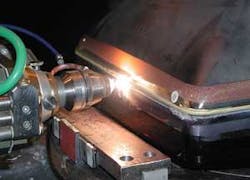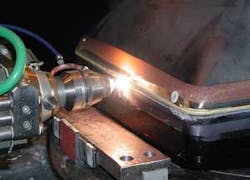Compared to diamond saw technology, laser cutting offers a process that is fast, high quality, low cost, and clean
Lars Aikala
Electronics waste is a globally recognized problem. The amount of obsolete equipment is increasing due to the rapid development and introduction of new technology. This waste is both an asset and a liability.
Electronics and electrical devices contain valuable metals and other materials, which make them an asset from a recycling point of view because they have a positive material value after logistics and treatment. Electronics, and especially older devices, also contain hazardous materials such as lead, cadmium, chromium six, and brominated flame retardants. To control these hazardous materials, new electronics recycling legislation, the WEEE-directive (Directive 2002/96/EC on waste electrical and electronic equipment) is being implemented in the European Union. The United States (several states including California), China, and other parts of the world are following.
Cathode Ray Tubes (CRTs) are a major issue in electronics recycling because they are abundant and because new flat screen and digital technology are replacing rapidly old CRT screens. These CRTs contain lead and phosphorous material, which is hazardous for the environment and health. Lead is contained in the funnel glass (back panel) and the phosphorous layer on the inside of the (front) panel glass.
The new electronics recycling legislation in Europe (WEEE-directive) tackles CRT recycling by creating rules on how to recycle and what the outcome should be. According to the WEEE-directive, 65 percent of the weight of a TV or a monitor has to be recycled. It also states that the CRT has to be removed from the casing and treated separately. In addition, the fluorescent layer on the inside surface of the panel glass has to be removed. This creates the following needs on the recycling technology. First the CRT has to be cut in two pieces so that the fluorescent layer can be removed safely and completely. Then this recycling process performance has to meet the requirement of reusing 65 percent or more of the weight of the old TV or monitor. The 65 percent target can be easily reached together with a positive value from the resale of the glass materials to CRT manufacturers if the separation of the glass materials (panel and funnel glass) is of high quality, that is, the panel glass may not contain lead-containing funnel glass and the funnel glass may not contain too much panel glass. In addition, the process must also have a high level of safety for the workers operating the recycling equipment.
Proventia Automation (Kempele, Finland; www.proventia.fi), a company that specializes in automation solutions for the recycling, packaging, and electronics industries, has developed and patented an industrial recycling solution to recycle CRTs from old and reject televisions and monitors. At the core of this solution is a laser cutting process. Before cutting the TV or monitor casing, electronics inside the casing need to be dismantled. After this the naked CRT enters the laser cutting unit, which measures its size and chooses the right cutting program to match this size. Then the CRT is moved into the cutting area, where the beam from a 1.5kW Rofin-Sinar CO2 laser cuts the CRT in two pieces. The laser can cut about one to two CRTs per minute depending on their size. Next, the front and back glass on the inside of the CRT needs to be cleaned. The metallic shadow mask and pins are removed and the phosphorous material is vacuumed and stored safely, to be processed later as hazardous waste. The leaded funnel glass and non-leaded panel glass are then cleaned in a cleaning drum, also developed by Proventia Automation, after which the glass is sold to manufacturers of new CRTs.
The laser offers several benefits compared to the competing diamond-saw technology. First, it is very fast; a single laser line solution from Proventia Automation can reach up to an annual processing capacity of 500,000 CRTs. Second, the solution produces high-quality separated CRT glass, which can be sold to CRT manufacturers. This is very important for the economics of the business and equally important for reaching the 65 percent target. Third, the solution has low operational costs, as the price of CO2 tanks and some mirrors is greatly lower than replacing diamond saws regularly. Laser cutting also produces significantly less dust in the cutting process, decreasing the risks to the worker’s health.
A critical factor to the CRT recycling business is the outlet for the glass. Currently there is no other large-scale reuse option for the glass other than making new CRTs. As sales of flat screens are increasing rapidly, many have expressed concern for the aftermarket for the glass. Market research by television and monitor manufacturers and independent bodies have shown that the CRT will still be the dominant screen format, in terms of volume, for the next five years, with more than 140 million produced annually. Because the CRT manufacturers can achieve significant cost savings on material and energy cost from using high-quality separated recycled CRT material, recyclers can do good business while benefiting the environment.
Proventia Automation has so far delivered one system to Finland, two to the UK, and one to Germany. The Finnish installation at CRT-Finland (Forssa), the first one, acted as pilot and test-site. It is now in full commercial use and can technically process all CRT waste from the Finnish market. The two installations in the UK, at Shore Recycling in Perth, Scotland, and Citiraya in Hirwaun, Wales, started operations in early 2005. The German installation at ZME Elektronik Recycling (Heuchelheim), which is also an R&D partner to Proventia, was also done in 2005. Proventia Automation is working with recyclers in the U.S. and China to get the first installations delivered there during 2005.
Rauno Partanen, the managing director of CRT Finland Oy, commenting on the CRT recycling issue and the laser cutting method, says, “When we were considering going into the CRT-recycling business an important issue for us was achieving a very high degree of recyclable materials after the process. Our choice of the laser was highly dependant on this, as it separates the two glass types to a degree that gives the best price for the glass. It’s important to understand that the glass also needs to be cleaned before it can be reused, and we are using Proventia’s cleaning technology for this. We have also invested in an electronics recycling process, so that now we can reintroduce 90 percent of the weight of a TV or a monitor to be reused. Another important issue for us is that the whole Proventia process is dry (cutting and cleaning), so we do not have to tackle issues with cleaning contaminated liquids.
“Our CRT-line has a theoretical maximum capacity to process all of the end-of-life CRTs in Finland and, even if the number of the CRTs is gradually dropping in the future, we believe the actual total mass of the CRTs processed may even increase in the future. As our CRT recycling process has very clean output, the glass materials could potentially be used as raw materials for other products than new CRTs.”
Lars Aikala is executive director at Proventia Automation. Contact him at [email protected].

